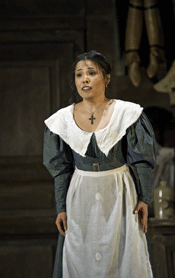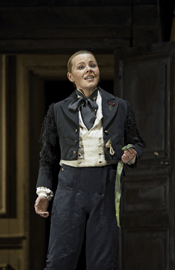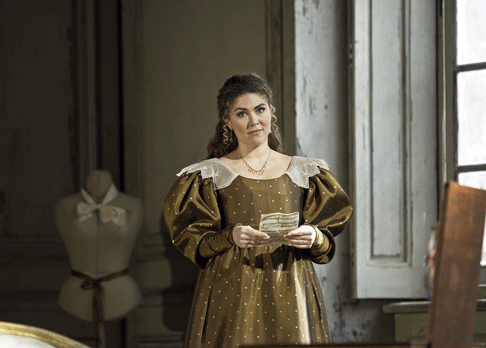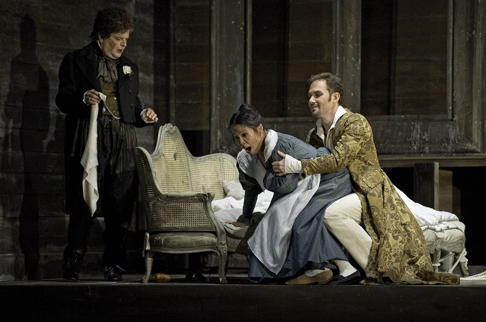![Erwin Schrott as Figaro [Photo by Clive Barda courtesy of The Royal Opera]](http://www.operatoday.com/NOZZE-100528_0410-SCHROTT-A.gif)
08 Jun 2010
Le Nozze di Figaro, Royal Opera House
Detailed and precise, but never fussy, David McVicar’s thought-provoking production of Le Nozze di Figaro is ‘busy’ from the opening rushing semi-quavers of the overture.
English Touring Opera are delighted to announce a season of lyric monodramas to tour nationally from October to December. The season features music for solo singer and piano by Argento, Britten, Tippett and Shostakovich with a bold and inventive approach to making opera during social distancing.
This tenth of ten Live from London concerts was in fact a recorded live performance from California. It was no less enjoyable for that, and it was also uplifting to learn that this wasn’t in fact the ‘last’ LfL event that we will be able to enjoy, courtesy of VOCES8 and their fellow vocal ensembles (more below …).
Ever since Wigmore Hall announced their superb series of autumn concerts, all streamed live and available free of charge, I’d been looking forward to this song recital by Ian Bostridge and Imogen Cooper.
Although Stile Antico’s programme article for their Live from London recital introduced their selection from the many treasures of the English Renaissance in the context of the theological debates and upheavals of the Tudor and Elizabethan years, their performance was more evocative of private chamber music than of public liturgy.
Evidently, face masks don’t stifle appreciative “Bravo!”s. And, reducing audience numbers doesn’t lower the volume of such acclamations. For, the audience at Wigmore Hall gave soprano Elizabeth Llewellyn and pianist Simon Lepper a greatly deserved warm reception and hearty response following this lunchtime recital of late-Romantic song.
For this week’s Live from London vocal recital we moved from the home of VOCES8, St Anne and St Agnes in the City of London, to Kings Place, where The Sixteen - who have been associate artists at the venue for some time - presented a programme of music and words bound together by the theme of ‘reflection’.
'Such is your divine Disposation that both you excellently understand, and royally entertaine the Exercise of Musicke.’
‘And there was war in heaven: Michael and his angels fought against the dragon; and the dragon fought and his angels, And prevailed not; neither was their place found any more in heaven … that old serpent … Satan, which deceiveth the whole world: he was cast out into the earth, and his angels were cast out with him.’
There was never any doubt that the fifth of the twelve Met Stars Live in Concert broadcasts was going to be a palpably intense and vivid event, as well as a musically stunning and theatrically enervating experience.
‘Love’ was the theme for this Live from London performance by Apollo5. Given the complexity and diversity of that human emotion, and Apollo5’s reputation for versatility and diverse repertoire, ranging from Renaissance choral music to jazz, from contemporary classical works to popular song, it was no surprise that their programme spanned 500 years and several musical styles.
The Academy of St Martin in the Fields have titled their autumn series of eight concerts - which are taking place at 5pm and 7.30pm on two Saturdays each month at their home venue in Trafalgar Square, and being filmed for streaming the following Thursday - ‘re:connect’.
The London Symphony Orchestra opened their Autumn 2020 season with a homage to Oliver Knussen, who died at the age of 66 in July 2018. The programme traced a national musical lineage through the twentieth century, from Britten to Knussen, on to Mark-Anthony Turnage, and entwining the LSO and Rattle too.
With the Live from London digital vocal festival entering the second half of the series, the festival’s host, VOCES8, returned to their home at St Annes and St Agnes in the City of London to present a sequence of ‘Choral Dances’ - vocal music inspired by dance, embracing diverse genres from the Renaissance madrigal to swing jazz.
Just a few unison string wriggles from the opening of Mozart’s overture to Le nozze di Figaro are enough to make any opera-lover perch on the edge of their seat, in excited anticipation of the drama in music to come, so there could be no other curtain-raiser for this Gala Concert at the Royal Opera House, the latest instalment from ‘their House’ to ‘our houses’.
"Before the ending of the day, creator of all things, we pray that, with your accustomed mercy, you may watch over us."
The doors at The Metropolitan Opera will not open to live audiences until 2021 at the earliest, and the likelihood of normal operatic life resuming in cities around the world looks but a distant dream at present. But, while we may not be invited from our homes into the opera house for some time yet, with its free daily screenings of past productions and its pay-per-view Met Stars Live in Concert series, the Met continues to bring opera into our homes.
Music-making at this year’s Grange Festival Opera may have fallen silent in June and July, but the country house and extensive grounds of The Grange provided an ideal setting for a weekend of twelve specially conceived ‘promenade’ performances encompassing music and dance.
There’s a “slide of harmony” and “all the bones leave your body at that moment and you collapse to the floor, it’s so extraordinary.”
“Music for a while, shall all your cares beguile.”
The hum of bees rising from myriad scented blooms; gentle strains of birdsong; the cheerful chatter of picnickers beside a still lake; decorous thwacks of leather on willow; song and music floating through the warm evening air.
![Erwin Schrott as Figaro [Photo by Clive Barda courtesy of The Royal Opera]](http://www.operatoday.com/NOZZE-100528_0410-SCHROTT-A.gif)
Detailed and precise, but never fussy, David McVicar’s thought-provoking production of Le Nozze di Figaro is ‘busy’ from the opening rushing semi-quavers of the overture.
Under the stern gaze of butlers and house-keepers, footmen and maids dart efficiently about the stage, tidying, carrying, dusting; this is a well-run household where everyone knows their place and their job. Well, almost everyone … for while the household machinery runs smoothly in the background, McVicar foregrounds the potential misery and heartache which may result from cross-class interactions of an amorous nature between servants and their imperious masters.
Upon this production’s first appearance in 2006, much was made of
McVicar’s decision to ‘update’ the action to the 1830s. But
this minor historical shift is neither especially remarkable nor inappropriate,
for the focus here is not political conflict but human passions. And, this
vision surely penetrates to the heart of this opera: for all its French
Revolutionary origins, it is at essence a tale of amorous confusions and
betrayals … it is in Don Giovanni (where the class divides are
just as obvious, and further highlighted by contrasting musical idioms) that we
hear the revolutionary cries of “Viva la liberté!”, whereas
Figaro explores human emotions — love, lust, envy, treachery
— as encapsulated by the Count’s words, ‘Shall I live to see
a servant of mine happy and enjoying pleasure that I desire in vain?’ Eri Nakamura as Susanna
Eri Nakamura as Susanna
The spacious stage, with widened proscenium arch, comfortably accommodates Tanya McCallin’s inventive sets, which slide ingeniously to emphasise the contrast between the luxurious grace of the courtly rooms and the shabby jumble of the servants’ quarters, while also revealing the co-dependence of the two worlds. In the Act 1 Trio, ‘Cosa sento!’, when the enraged Count discovers the unfortunate page, Cherubino, hiding in Susanna’s room, servants listen avidly outside the door, relishing the commotion within. As the Count rants, rages and plans revenge in ‘Hai già vinta la causa!’, butlers and housemaids silently go about their business, diplomatically deaf to their master’s indiscreet outpourings.
McVicar is alert to every potential for realism: there are some neat contemporary references — Count Almaviva inspects some new scientific machinery at the start of Act 3, for example — and there is not an anachronism or improbability in sight. With this particular Susanna a good foot shorter than the Countess, disguise and mistaken identity become more improbable, so McVicar stands his Susanna on a box, just one example of the understated dramatic integrity of the whole.
The transitions between locations are imperceptible and creative, none more so that between Acts 3 and 4, where the imposing interior smoothly and almost indiscernibly transforms to become a nocturnal garden, beautifully and evocatively lit by Paule Constable.
The performances of the fairly young cast of principals were similarly
well-matched, marked by musical accuracy and dramatic credibility. Erwin
Schrott as Figaro sang with naturalism and ease: his perturbed servant is not
an over-confident, boastful buffoon, but rather a man of cool intelligence and
wit, who really is in control of the commotion. Although he lacks some power in
the lower range, Schrott’s performance is impressive and unceasingly
entertaining. There is not a wasted moment or irrelevant gesture, as when he
quick-wittedly improvises a limp when his lies about leaping from the
Countess’s window are almost uncovered by the Count. When the hunting
fanfares trill out in ‘Aprite un po’ quegli occhi’, Schrott
waggles his cuckold’s horns, but while his horror at Susanna’s
imagined infidelity seems genuine at this point, we are confident that he will
manage events to his benefit; and his wry comic nuance in the ensuing
denouement was superb. Jurgita Adamonytė as Cherubino
Jurgita Adamonytė as Cherubino
In an unusually vicious interpretation, Mariusz Kwiecien was a portrait of pride and brutal petulance as Count Almaviva. This was really dramatic singing. Drawing upon a wide range of colours in his Act 3 aria, ‘Vedrò, mentr’io sospiro’, Kwiecien suggested not a petty aristrocrat’s frustration at not getting his own way, but genuine fury and ferocity. However, the surprising slap which he inflicted upon the Countess during their argument about Cherubino’s whereabouts seemed inappropriate — such nastiness and intimated cruelty is hard to reconcile with their apparently harmonious reunion at the close of the opera.
Eri Nakamura is still a Jette Parker Young Artist but she showed musical maturity, and stamina, as Susanna. Secure and poised throughout, she held her own among more her experienced colleagues. However, it was a pity that, when Da Ponte’s libretto contributes so much to the wit and irony of the opera, her Italian was almost unintelligible! Jurgita Adamonytė convincingly conveyed Cherubino’s restless energy and capacity for mischief. Her intonation was secure, her tone crisp and clear, and she shaped Mozart’s lyrical lines in ‘Voi che sapete’ with grace; but while she dashed gauchely about the stage, vocally perhaps she was a bit too elegant and controlled, not quite capturing Cherubino’s breathless excitement and urgency.
German soprano, Annette Dasch, was making her ROH debut as the Countess. Although she was a little nervous and unsteady at the start, she relaxed after a slightly strained ‘Porgi amor’, and blended sweetly with Nakamura in their Act 3 Canzonetta. However, ‘Dove sono’ was a little too pressing and tense for my liking; accompanied by wonderful woodwind playing, Dasch lacked richness at the top of her voice and in the climactic closing phrases pushed to forcefully to the top As, lacking somewhat the composure and restraint required to suggest the Countess’s deeply felt but poignant regret.
 Annette Dasch as Countess Almaviva
Annette Dasch as Countess Almaviva
Marie McLaughlin is an experienced Marcellina and she was clearly comfortable in the role, enjoying the on-stage business and singing with bright tone and precision — it was a pity that her Act 4 aria was cut. McLaughlin’s sense of timing was more than equalled by Robert Lloyd as Bartolo, and they made a wonderful comic pair, the latter despatching the prattling patter of ‘La vendetta’ with ease.
Peter Hoare was a suitably snide and sneering Basilio, although he might have made even more of his comic moments, such as the repetition of his line, ‘What I said about the page, it was just a suspicion …’ in ‘Cosa Sento’. Nicholas Folwell’s Antonio was convincingly furious at having his flowerbeds trampled by Cherubino, and certainly not keen on acquiring him as a son-in-law! American soprano, Amanda Forsythe, confidently delivered Barbarina’s Act 4 aria with polished style and lovely refinement, and Christopher Gillett was a very competent Don Curzio.
Just one weakness marred the otherwise superb singing: the cast, most especially during the ensembles, on occasion lagged behind the spirited pace set by Sir Colin Davis in the pit, clouding the orchestra’s sharp clarity and liveliness. The servants’ chorus which closes Act 1 was particularly marred in this way. Post-interval, after an announcement informed us that due to unforeseen circumstances Davis had had to leave the theatre, the problem continued under the baton of David Syrus, Head of Music for The Royal Opera House, who is scheduled to conduct later performances of the run. Although he did not always sustain the dramatic momentum in the final Act, with its extended sequence of arias and recitatives, Syrus built impressively towards the close in the final ensemble.
 Peter Hoare as Don Basilio, Eri Nakamura as Susanna and Mariusz Kwiecien as Count Almaviva
Peter Hoare as Don Basilio, Eri Nakamura as Susanna and Mariusz Kwiecien as Count Almaviva
McVicar’s production will doubtless and deservedly become a Covent Garden staple. But, it needs a slightly more stellar cast if it is to really sparkle. On this occasion, as the servant’s curtsey which accompanied the closing bars implied, it was the production itself which was star of the show.
Claire Seymour